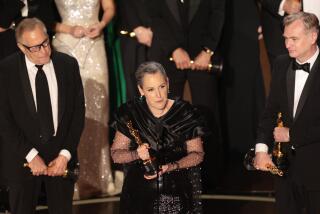A supersonic master
SKYWALKER RANCH, Calif. -- What does an Oscar nomination sound like? For Randy Thom, it sounds like chalk raking down a blackboard combined with a stallion’s whinny and an elephant trumpeting. It can also sound like 200 gas ovens flaring to life in unison or the scratch and squeal of quarreling rats.
Thom, the director of sound design at Skywalker Sound, this year has earned the 13th and 14th Academy Award nominations of his career, and he very much likes the sound of that. This time, the sonic artisan is up in the categories of sound editing and sound mixing for “Ratatouille.”
“I still lose sleep the night before the nominations,” Thom said during a recent afternoon interview at the Technical Building at George Lucas’ Skywalker Ranch in Marin County, Calif. “This year, the work on ‘Ratatouille’ was very satisfying but also a challenge -- any time you work with Brad Bird, it’s a challenge. . . . He’s a master storyteller, and he uses sound for all it’s worth.”
Director-writer Bird’s work on “Ratatouille” has also earned him two nominations (best original screenplay and best animated feature film) going into the 80th annual Academy Awards at the Kodak Theatre. Bird had Thom already working on rat sounds while he was writing the screenplay.
“We did this also on ‘The Incredibles’ and ‘[The] Iron Giant.’ We’re talking to each other very early on. . . . I’m sending him back sounds and ideas that actually help him shape the story and scenes,” Thom said. “Brad is very much in the school of thought that sound can do half the storytelling, and hearing those sounds early on gets light bulbs turning on in his head.”
In the case of “Ratatouille,” Thom’s early recordings of rats were exhausting (“Rats don’t squeak on demand,” Thom said with a groan), but they led Bird to a key determination: His rats would speak in human English, without some sort of high-pitched squeal. “Anything else would be a distraction,” Thom said.
There was one exception -- a scene in which a woman watches two rats argue and, from her point of view, it’s an angry exchange in rodent chirping. Thom used the actors’ voices and altered them to create the sound to keep the audience aware, even subconsciously, of who was whom. The greatest challenge was an extended scene with Remy (Patton Oswalt) making his first entrance into a Paris kitchen. It’s a tour de force in which human footfalls echo like Godzilla stomps and an oven feels like a firestorm.
“That sound of a gas oven turning on, you only get that in the first second and a half of turning on the jets, so we used the sound from 200 ovens and put them together to give that surge,” Thom said, sitting at a control board near a large framed photo from “The Conversation,” the 1974 Francis Ford Coppola film about a surveillance man whose recordings get him caught up in deadly intrigue. The movie was considered a triumph for its use of sound, created by Coppola’s noted collaborator, Walter Murch, who is credited with coining the term “sound designer.”
“That’s up there for inspiration -- Walter was the main brain behind a lot of what we do,” Thom said. “Those two and George are behind everything we do here and the idea that the sound should be a full collaborator in the story.”
Thom came up through radio, working on dramas and documentaries, and his first film was “Apocalypse Now.” Murch got an Academy Award for the 1979 film, and his new protege was fascinated watching him. Thom had noticed that if you set a short-wave radio on null frequencies, there would be a fluttering sound, a sort of ghostly strafing. Thom thought it sounded like a helicopter, but Murch used it as memorable background distortion for an audiotape recording of Col. Kurtz, Marlon Brando’s mad military man.
Thom earned his first Oscar a few years later on “The Right Stuff.” While at Edwards Air Force Base recording playground sounds for a scene in the space-race epic, Thom heard a teacher drag a piece of chalk down a blackboard. The ear-piercing result became part of an audio collage.
“There’s the scene when Chuck Yeager really kicks in the ignition of the F-1 and there’s a shot of flames exploding out from the back of the plane. We used that chalk sound along with an elephant and horse as well as rocket and jet sounds. They were things that sound out of control.”
Thom, who went on to work on “Backdraft,” “Forrest Gump,” “Contact,” “The Polar Express” and “The Incredibles” (for which he won an Oscar), said the ascent of “serious” animation and the ongoing era of special-effects films has brought in a generation of directors that are far more open to sound design early in the process.
“But there is still this lingering misconception, even in the movie business, that sound is an afterthought, that the way it works is you go out and record actors on the set and edit the film and add some music and sound effects,” Thom said. “But the most crucial part of sound design is when you are writing the story -- the points of view of the characters and the locations they find themselves in, whether you allow for moments in dialogue to establish what a place sounds like.” Thom said the key is his “found sounds.” “What it comes down to is the approach of a sound designer. A craftsman learns how to avoid mistakes. An artist knows how to use them.”
--
More to Read
Only good movies
Get the Indie Focus newsletter, Mark Olsen's weekly guide to the world of cinema.
You may occasionally receive promotional content from the Los Angeles Times.









